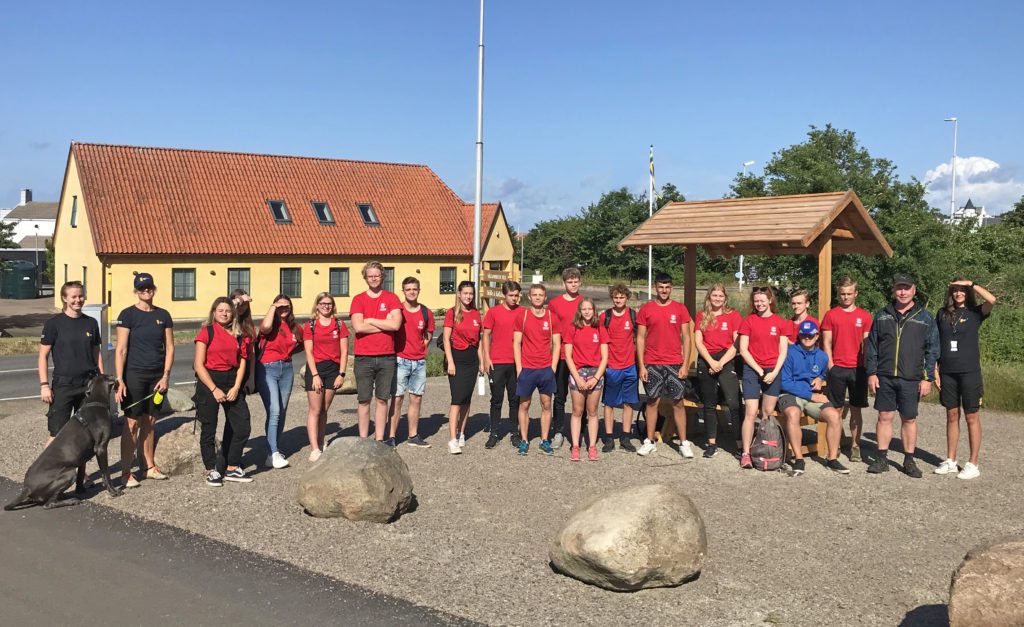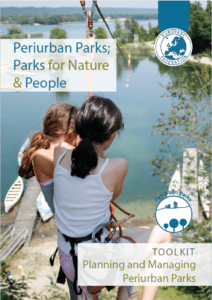Case Study: Junior Rangers and Youth+ as team leaders for young summer workers
Youth summer workers in Kullaberg
EUROPARC’s Youth+ Programme is all about empowering young people and providing them with opportunities to work on their conservation, communication, advocacy and leadership skills. Check out how Kullaberg Nature Reserve did just that!
Youth summer workers project

Förslag JR 2017
Kullaberg Nature Reserve is Sweden’s most visited nature reserve, with more than 500.000 visitors annually in a very small area. Because of that, every year summer season with its influx of visitors brings a lot of pressure to the management of the Park. To manage this, the Reserve employs young summer workers, to assist with repairs, cleaning litter, information, parking coordination, etc. This is a coordinated effort with the municipality and brings benefits to both youngsters still in school, who are being offered a summer job, and to the Kullaberg Nature Reserve, which is in need of extra pair of hands to help out wherever needed.
Employing Junior Rangers and Youth+ as team leaders for young summer workers
Summer workers usually have little or no experience of the nature reserve, therefore, a lot of time and effort from the staff of the nature reserve was needed to coordinate their work and instruct them. There was a clear need for guidance for these youngsters. The quality and coordination of their tasks could be improved and the ordinary staff needed to be relieved of the added burden of managing them as well.
Recently, older Junior Rangers and Youth+ were introduced as team leaders for the summer workers and demonstrated to be extremely helpful to channel knowledge of the area as well as know-how to the group.

Solutions and Actions taken
- Using one of the certified guide companies of the area, Kullabergsguiderna, to supervise and coordinate the summer workers, the ordinary staff was relieved from some work. Kullabergsguiderna was contacted early in the spring, to ensure enough time to coordinate the project.
- Older Junior Rangers and Youth+ were employed as team leaders for the group. They have been involved with the Park for a longer period of time already, and this allowed them to share their extensive knowledge of the area.
Challenges encountered
Since summer is the high season for the guide company, their time was extremely limited during the duration of the project and the main planning had to be done well in advance. Moreover, establishing functional communication between ordinary nature reserve staff, team leaders and the supervising guide company required a lot of organizational effort.
Outcomes
With the help of the Junior Rangers and Youth+, the summer workers job has been much more efficient and by speeding up the communication with existing staff, action could be taken quickly to tackle any unforeseen issues.
Using youngsters from the Junior Rangers and Youth+ programme not only as ambassadors for the nature reserve but also as spokespersons for empowering youth, proved to be the perfect fit for leading the young summer workers.
Project Partners

Local Guide Company

For more info on Kullaberg Nature Reserve visit their website.
Find out more about Junior Rangers and Youth+ networks on EUROPARC’s dedicated website pages!
Presentation of the Yearbook 2020 of the State of Protected Areas in Spain.
Cover of the Yearbook 2020 prepared within the framework of the ADAPTASALUDEA project, "Contribution of protected areas to adaptation to climate change, human health and environmental education for sustainability", developed with the support of the Biodiversity Foundation of the Ministry for the Ecological Transition and Demographic Challenge".
A reference document on the state of conservation of Spanish natural heritage
On December 15, the Fernando González Bernáldez Foundation – EUROPARC Spain presented in Madrid the Yearbook 2020 of the state of protected areas in Spain.
The report was prepared with the support of the Biodiversity Foundation of the Spanish Ministry for the Ecological Transition and the Demographic Challenge and within the framework of the ADAPTASALUDEA project. It presents the main advances in conservation of Protected Areas carried out in Spain to date, key information on the number of protected areas in this country and its conservation and management state. It also highlights relevant information on the main opportunities and challenges they present.
The Yearbook 2020 of the State of Protected Areas in Spain is available in Spanish here.
Spain and the Natura 2000 Network
According to the Yearbook 2020, Spain is the country that contributes with most land surface to the Natura 2000 Network, with more than 27% of its land area, having more than 80% of these areas approved management plans. In addition, Spain is the country with the greatest representation of biosphere reserves in the world, with a total of 53.
If the total of existing protected areas in this country is taken into account, Spain has 36.2% of its land surface and 12.3% of its marine surface protected. This places the country in a favourable position to achieve the European conservation objectives established in the Biodiversity Strategy 2030, which proposes to achieve 30% protection of the total surface of our continent.
“Since 2019, 31 new protected natural areas have been declared in Spain”
Spain currently shelters 16 National Parks, 152 Natural Parks, 291 Natural Reserves, 359 Natural Monuments, 61 Protected Landscapes and 2 Marine Protected Areas. Additionally, 800 natural spaces are designated under different figures developed by the chartered communities of the country.

Parc natural del Montgrí, les Illes Medes i el BaixTer – Santi Perez
Challenges ahead
However, the document also emphasizes certain challenges for the conservation of the Spanish natural heritage, such as progressing towards a more effective Protected Area management in an increasingly complex context that requires reinforcing the available means to face the challenges of global change. Likewise, new emerging challenges originated by the COVID-19 pandemic have appeared, such as the visitor saturation in certain protected areas or the absence of visitors in others, which provides an opportunity to review the new needs for the management of public use. Finally, the existing need to ensure that an adaptive and efficient management of Protected Areas is implemented, which requires adequate materials, economic and human resources.
Management underway
The challenges of the future must be approached from experience and professional background. In this new edition of the Yearbook 2020, a section has been incorporated for the first time in which different experiences in Protected Areas are documented. This chapter includes a total of 13 inspiring experiences, nine initiatives that illustrate the role of Protected Areas against Climate Change and four experiences in which the benefits for human health and well-being derived from the adequate management of Protected Areas are valued.
The campaign Nuestros Espacios Protegidos
As a result of this report, the Global Nature Foundation, EUROPARC- Spain and the Ecotourism Association of Spain have launched the campaign Nuestros Espacios Protegidos – Our Protected Spaces in order to give visibility to this milestone, raise social awareness on the importance of maintaining and caring for these areas, and promote ecotourism as a tool for conserving biodiversity and contributing to local development.
More information about the campaign available in this video:
New EUROPARC Toolkit: Planning and Managing Periurban Parks
Grand Parc Miribel Jonage, by Mathilde André
EUROPARC presents the new toolkit: “Planning and Managing Periurban Parks”. A document focused on Periurban Parks and their essential role in nature and people health and wellbeing, as well as in mitigating the local climate and serving as places for local food production.
Periurban Parks as tools to meet multiple purposes and reconcile conflicting needs
Periurban Parks are the green lungs of our cities, they naturally provide valuable breathing space, both for nature and for people to exercise and improve their health and well-being. Periurban Parks moderate local climate and act as places for local food production. To underline the importance of these periurban green gems, and to give practical advice on their planning, design and management measures, EUROPARC created the toolkit Planning and Managing Periurban Parks.
Download the toolkit here
The toolkit
The toolkit aims at giving all protected Areas interested the opportunity to learn from the direct experience of Periurban Parks. It is also a useful tool for policy-makers wanting to promote the protection of natural greenspaces in and around cities. Additionally, this kit is full of links to web pages and studies useful for further reference.
How can it help you?
This toolkit is structured around 5 topics:
- Designing the Park
- Enhancing Biodiversity
- Hosting People
- Communicating and learning with People – Awareness Raising & Environmental Education
- Working with People – Governance & Partnerships
For each topic, a range of tips, tools, information and inspiration are provided.

This toolkit was produced by the EUROPARC Federation and the Members of the Periurban Commission.

Life logo
The production of this publication has received funding from the LIFE Programme of the European Union. The content of this publication does not reflect the official opinion of the European Union. Responsibility for the information and views expressed in the publication lies entirely with the authors.
Restoring nature in the EU cannot wait
EUROPARC is one of 150 other NGOs in the EU that call upon the European Commission to include overarching – and ambitious – targets in the EU law to restore nature.
On 14 December, over 150 environmental NGOs from across Europe sent a letter to the European Commission Executive Vice-President Frans Timmermans and the Environment Commissioner Viginijus Sinkevičius raising concerns about the overall ambition of the EU Nature Restoration Law, which is in the final stages of preparation by the European Commission.
EUROPARC and the other joining NGOs are strongly convinced that clear measurable targets for land area, river length and sea area are the key elements to make this legislation as ambitious, adequate and effective as possible. Just as with the Climate Law, a robust and understandable EU headline target, overarching the individual ecosystems (and species) specific targets, is indispensable for mobilising Member States’ action at the required scale. Additionally, it can facilitate the monitoring of individual Member States’ contributions, thus ensuring the timely achievement of the EU-wide targets.
That’s why we are advocating for a target to restore at least 15% of the EU’s land area, river length and sea area by 2030, to which all underlying ecosystem specific targets should contribute. That would mean restoration of 650,000 km2 on land, 1,000,000 km2 of marine EU area and 178,000 km of rivers.
KEY MESSAGES:
- The upcoming EU nature restoration law needs to include overarching targets to restore at least 15% of the EU’s land, river length and sea area by 2030.
- We cannot afford to wait to restore Europe’s nature on a large scale.
- Large-scale and targeted nature restoration can create synergies between the responses to the climate and biodiversity crises.
The time to act is now.



